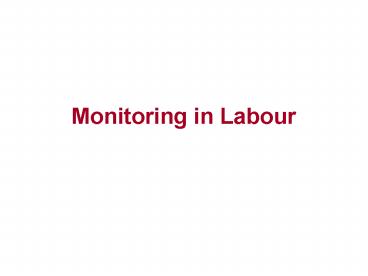Monitoring in Labour - PowerPoint PPT Presentation
Title: Monitoring in Labour
1
Monitoring in Labour
2
Objectives
- Discuss fetal heart rate patterns using
Continuous Electronic Fetal Monitoring (CEFM)
tracings. - Compare the evidence between EFM and structured
intermittent auscultation (SIA) - Discuss relevant physiology in fetal monitoring
- Describe systematic approaches in fetal
monitoring using Dr C Bravado - Outline guidelines for fetal heart rate
monitoring using SIA
3
CEFM vs. SIA
- Perinatal outcomes
- 50 reduction in neonatal seizures (RR0.50, 95CI
0.31-0.80) - but no significant difference in incidence of
- - long-term neurological handicap (RR1.74,
95CI 0.97-3.11) - - or perinatal mortality
(RR0.85, 95CI 0.59-1.23) - Obstetric outcomes
- - 66 increase in C. Section rate (RR1.66, 95CI
1.30-2.13) - - 16 increase in instrumental delivery (RR1.16,
95CI 1.01-1.32) - Alfiveric Z et al, Cochrane Database
Syst Rev 2006
4
Pathophysiology of FH rate changes
- Changes in FH rate patterns occur in response to
changes in O2, CO2, hydrogen ions and arterial
pressure - These changes are mediated via the vagus nerve,
chemoreceptors carotid body baroreceptors - It is difficult to measure fetal oxygenation and
pH continuously - FH rate patterns only allow indirect assessment
of fetal acid-base balance. Fetal scalp sampling
is required to confirm whether the fetus is
hypoxic - Hinshaw K Ullal A. Anaes Int Care Med (Aug 2007)
5
A systematic approach to CTG interpretation using
EFM
- DR. C. BRAVADO
- Determine Risk
- Contractions (lt 5 in 10)
- Baseline Rate (110-150bpm)
- Variability (gt5)
- Accelerations-reassuring
- Decelerations
- Overall Assessment Plan
- Few centres in Tanzania have this facility -
refer to ALSO - manual for further information
6
DR C BRAVADO
A systematic approach to CTG interpretation
- Determine Risk
- Assess degree of clinical risk in relation to
clinical outcome - High
- Low
Comparable to TRAFFIC LIGHTS
7
Risk Factors
- Maternal
- Previous Caesarean section
- Pre-eclampsia
- Pregnancy gt42 weeks
- Prolonged ROM gt24 hours
- Diabetes
- Antepartum haemorrhage
- Significant medical condition eg cardiac
8
Risk Factors
- Fetal
- Intrauterine growth restriction
- Oligohydramnios
- Preterm labour
- Multiple pregnancy
- Breech presentation
9
Risk Factors
- Intrapartum
- Significant meconium-stained liquor
- Abnormal FHR on auscultation
- baseline lt110 or gt160 bpm
- any decelerations after a contraction
- Maternal pyrexia
- Fresh bleeding in labour
- Oxytocin augmentation
10
DR C BRAVADO
- A systematic approach to CTG interpretation
- Assess contraction pattern
- Rate
- Duration of contractions
- Coordinate or In-coordinate?
- Baseline Tone
11
DR C BRAVADO
- A systematic approach to CTG interpretation
- Baseline Rate
- Normal range 110-160bpm
- Baseline Bradycardia lt110
- Baseline Tachycardia gt160 bpm
12
BASELINE RATE
- BRADYCARDIAlt110
- Gestation gt 40 weeks
- Cord compression
- Congenital heart malformations
- Drugs eg.benzodiazepines
- TACHYCARDIAgt160
- Excessive fetal movement
- Maternal anxiety
- Gestation lt32 weeks
- Maternal pyrexia
- Fetal infection
- Chronic hypoxia
13
DR C BRAVADO
- A systematic approach to CTG interpretation
- Variability
- The presence of normal fetal heart rate
variability is one of the best indicators of
intact integration between the central nervous
system and the heart of the fetus - Normal 5 bpm
14
VARIABILITY
Persistent absence of or reduced variability is
potentially ominous
Reduced Normal
15
DR C BRAVADO
- A systematic approach to CTG interpretation
- Accelerations
- Increase of at least 15 bpm above the baseline
- for at least 15 seconds
- Associated with movement or stimulation
- Presence is the single best indicator of fetal
- well-being
- An antenatal CTG should always contain
accelerations to be considered normal.
16
ACCELERATIONS
3 examples are highlighted
17
DR C BRAVADO
- A systematic approach to CTG interpretation
- Early Decelerations mirror contractions
- Fall of lt60 beats from baseline associated
(almost exclusively) with excellent fetal outcome - True early uniform decelerations are rare and
benign and therefore not significant
18
DR C BRAVADO
- A systematic approach to CTG interpretation
- Variable Decelerations
- Most decelerations in labour are variable
- Can reflect cord compression
- Variable in shape, depth and/or onset
- Usually benign but . if late or deep may imply
cord prolapse or hypoxia - Need to assess the frequency and duration
19
VARIABLE DECELERATIONS
20
COMPLICATED VARIABLES
21
DR C BRAVADO
- A systematic approach to CTG interpretation
- Late Decelerations
- Associated with fetal compromise (hypoxia)
- but only in 50-60 of cases
- Ominous if associated with
- - fresh particulate meconium
- - high-risk clinical situation
- Ominous if
- - ? lag-time (peak to trough)
- - deceleration is slow to recover
22
LATE DECELERATIONS
- Begin after onset of contraction
- Nadir (or trough) after peak of contraction
- Return to baseline after end of contraction
23
Structured Intermittent Auscultation
- In Active phase of labour
- MINIMUM OF 60 SECONDS after a contraction
- Differentiate maternal pulse
- Each 30 minutes in first stage of labour
- Each 15 minutes if any risk factor
- After each contraction while actively pushing
24
- If fetal heart rate persist
- above 180 bpm or below 100 bpm
- plan delivery
- If the cervix is fully dilated and the fetal head
is not more than 1/5 above the symphysis pubis
(or at station 0 or below) deliver by vacuum - If the cervix is not fully dilated or the fetal
head is more than 1/5 above the symphysis pubis
(or above station 0) deliver by cesarean section - Managing obstetric complications, WHO
25
(No Transcript)































